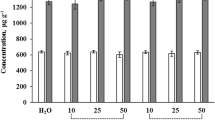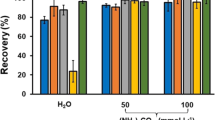Abstract
In this study, the effects of wet and microwave digestion methods for the determination of cupper (Cu), iron (Fe), and zinc (Zn) in standard reference materials (SRMs) and food samples by using flame atomic absorption spectrometry (FAAS) were investigated. HCl, HNO3, and HNO3 + H2O2 mixture were applied to the digestions of the SRMs (IRMM-804 rice flour, GBW 10010 rice, GBW 10011 wheat flour, 1567a wheat flour and 1571 orchard leaves) for optimization and validation of the method by using wet and microwave digestion systems. Concentrations of Cu, Fe and Zn in SRMs were determined by FAAS, and the lowest percent relative errors of analytes (from −2.5 % to +3.0 %) were obtained by using HNO3 + H2O2 mixture in the microwave digestion. Limit of detection (LOD) and limit of quantification (LOQ) values for analytes obtained by using HNO3 + H2O2 mixture in the microwave digestion were 14.5 and 48.3 μg L−1 for Cu, 16.4 and 54.6 μg L−1 for Fe, and 10.8 and 36.0 μg L−1 for Zn, respectively. The concentrations of Cu, Fe and Zn in food samples such as wheat flour, corn flour, rice flour and tahini were determined by FAAS using the HNO3 + H2O2 mixture in both wet and microwave digestion systems. It was observed that the results obtained with microwave digestion were higher than those of wet digestion. The concentrations of Cu, Fe and Zn in samples found by microwave digestion were compared with the maximum permissible values given in the Turkish standards, regulations and some literature values.
Similar content being viewed by others
References
Aberoumand A, Deokule SS (2009) Determination of elements profile of some wild edible plants. Food Anal Methods 2:116–119. doi:10.1007/s12161-008-9038-z
Akbulut M, Ozcan MM (2009) Comparison of mineral contents of mulberry (Morus spp.) fruits and their pekmez (boiled mulberry juice) samples. Int J Food Sci Nutr 60(3):231–239. doi:10.1080/09637480701695609
Akinyele IO, Shokunbi OS (2015) Comparative analysis of dry ashing and wet digestion methods for the determination of trace and heavy metals in food samples. Food Chem 173:682–684. doi:10.1016/j.foodchem.2014.10.097
Allen L, de Benoist B, Dary O, Hurrell R (2006a) Guidelines on Food fortification with micronutrients. World Health Organization/Food and Agricultural Organization of the United Nations, Geneva Switzerland page 310
Allen L, De Benoist B, Dary O, Hurrell R (2006b) Guidelines on food fortification with micronutrients. World Health Organization/Food and Agricultural Organization of the United Nations, Geneva Switzerland page 149
Altundağ H, Tüzen M (2011) Comparison of dry, wet and microwave digestion methods for the multi element determination in some dried fruit samples by ICP-OES. Food Chem Toxicol 49:2800–2807. doi:10.1016/j.fct.2011.07.064
Ayman AG (2016) A new coprecipitation method without carrier element for separation and preconcentration of some metal ions at trace levels in water and food samples. Talanta 146:435–441. doi:10.1016/j.talanta.2015.09.005
Bakırcıoğlu D, Bakırcıoğlu KY, Yurtsever S (2013) Comparison of extraction induced by emulsion breaking, ultrasonic extraction and wet digestion procedures for determination of metals in edible oil samples in Turkey using ICP-OES. Food Chem 138:770–775. doi:10.1016/j.foodchem.2012.10.089
Batista ÉF, Pessoa AGG, Guerra MBB, Miranda K, Pereira-Filho ER (2013) Fast sequential determination of As and Sb, Bi and Pb by continuous flow hydride generation atomic absorption spectrometry. Food Anal Methods 6:1212–1222. doi:10.1007/s12161-012-9528-x
Ćernohorský T, Krejćová A, Pouzar M, Vavrušová L (2008) Elemental analysis of flour-based ready-oven foods by slurry sampling inductively coupled plasma optical emission spectrometry. Food Chem 106:1246–1252. doi:10.1016/j.foodchem.2007.07.031
Chevallier E, Chekri R, Zinck J, Guérin T, Noёl L (2015) Simultaneous determination of 31 elements in foodstuffs by ICP-MS after closed-vessel microwave digestion: method validation based on the accuracy profile. J Food Compos Anal 41:35–41. doi:10.1016/j.jfca.2014.12.024
Da-Col JA, Domene SMA, Pereira-Filho ER (2009) Fast determination of Cd, Fe, Pb, and Zn in food using AAS. Food Anal Methods 2:110–115. doi:10.1007/s12161-008-9041-4
Daşbaşı T, Saçmacı Ş, Ülgen A, Kartal Ş (2015) A solid phase extraction procedure for the determination of Cd(II) and Pb(II) ions in food and water samples by flame atomic absorption spectrometry. Food Chem 174:591–596. doi:10.1016/j.foodchem.2014.11.049
Ekinci R, Ünal S (2002) Mineral contents of various flour types produced in different region of Türkiye. Pamukkale Univ Eng Faculty J Eng Sci 8:91–96
Ferreira HS, Santos ACN, Portugal LA, Costa ACS, Mirób M, Ferreira SLC (2008) Pre-concentration procedure for determination of copper and zinc in food samples by sequential multi-element flame atomic absorption spectrometry. Talanta 77:73–76. doi:10.1016/j.talanta.2008.05.056
Harris DC (2011) Quantitative chemical analysis. 8. Ed. W.H. Freeman and Company, New York, USA pages 73-79
Huang S-Y, S-Jen J, Sahayam AC (2014) Ultrasonic slurry sampling electrothermal vaporization inductively coupled plasma mass spectrometry for the determination of Cr, Fe, Cu, Zn and Se in cereals. Spectrochim Acta B 101:46–50. doi:10.1016/j.sab.2014.07.015
Karaca İ (2009) Determination of vitamin and mineral in fruit juice concentrates, Msc. Thesis, Inonu University, Department of Basic Pharmaceutical Faculty Malatya Turkey, p: 95-96
Kılıç S, Yenisoy-Karakaş S, Kılıç M (2015) Metal contamination in fruit juices in Turkey: method validation and uncertainty budget. Food Anal Methods 8:2487–2495. doi:10.1007/s12161-015-0136-4
Mendil D, Karataş M, Tüzen M (2015) Separation and preconcentration of Cu(II), Pb(II), Zn(II), Fe(III) and Cr(III) ions with coprecipitation method without carrier element and their determination in food and water samples. Food Chem 177: 320-324. doi: 10.1016/j.foodchem.2015.01.008
Saraçoğlu S, Tüzen M, Soylak M (2009) Evaluation of trace element contents of dried apricot samples from Turkey. J Hazard Mater 167:647–652. doi:10.1016/j.jhazmat.2009.01.011
Tokalıoğlu Ş, Gürbüz F (2010) Selective determination of copper and iron in various food samples by the solid phase extraction. Food Chem 123:183–187. doi:10.1016/j.foodchem.2010.04.012
Tokman N (2007) The use of slurry sampling for the determination of manganese and copper in various samples by electrothermal atomic absorption spectrometry. J Hazard Mater 143:87–94. doi:10.1016/j.jhazmat.2006.08.068
TS 12001 (1996) Pekmez (Made From Mulberry)
TS 2589 (2006) Tahini
TS 3792 (2008) Pekmez (Traditional Turkish grape juice concentrate)
Yılmaz E, Soylak M (2014) Development a novel supramolecular solvent microextraction procedure for copper in environmental samples and its determination by micro sampling flame atomic absorption spectrometry. Talanta 126:191–195. doi:10.1016/j.talanta.2014.03.053
Author information
Authors and Affiliations
Corresponding author
Ethics declarations
Funding
This study was not funded by the University research grant or a company.
Conflict of Interest
Orhan Acar declares that he has no conflict of interest. Adalet Tunçeli declares that she has no conflict of interest. Ali Rehber Türker declares that he has no conflict of interest.
Human and Animal Rights and Informed Consent
This article does not contain any studies with human or animal subjects.
Rights and permissions
About this article
Cite this article
Acar, O., Tunçeli, A. & Türker, A.R. Comparison of Wet and Microwave Digestion Methods for the Determination of Copper, Iron and Zinc in Some Food Samples by FAAS. Food Anal. Methods 9, 3201–3208 (2016). https://doi.org/10.1007/s12161-016-0516-4
Received:
Accepted:
Published:
Issue Date:
DOI: https://doi.org/10.1007/s12161-016-0516-4




